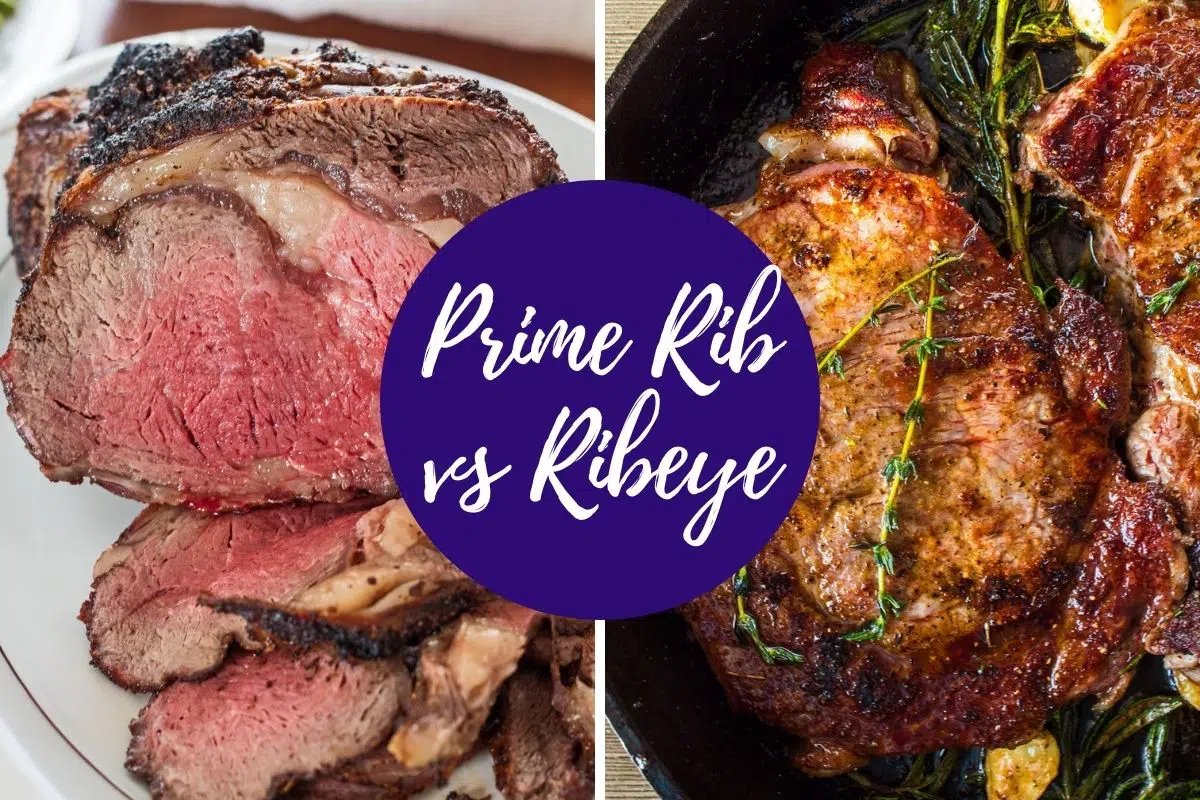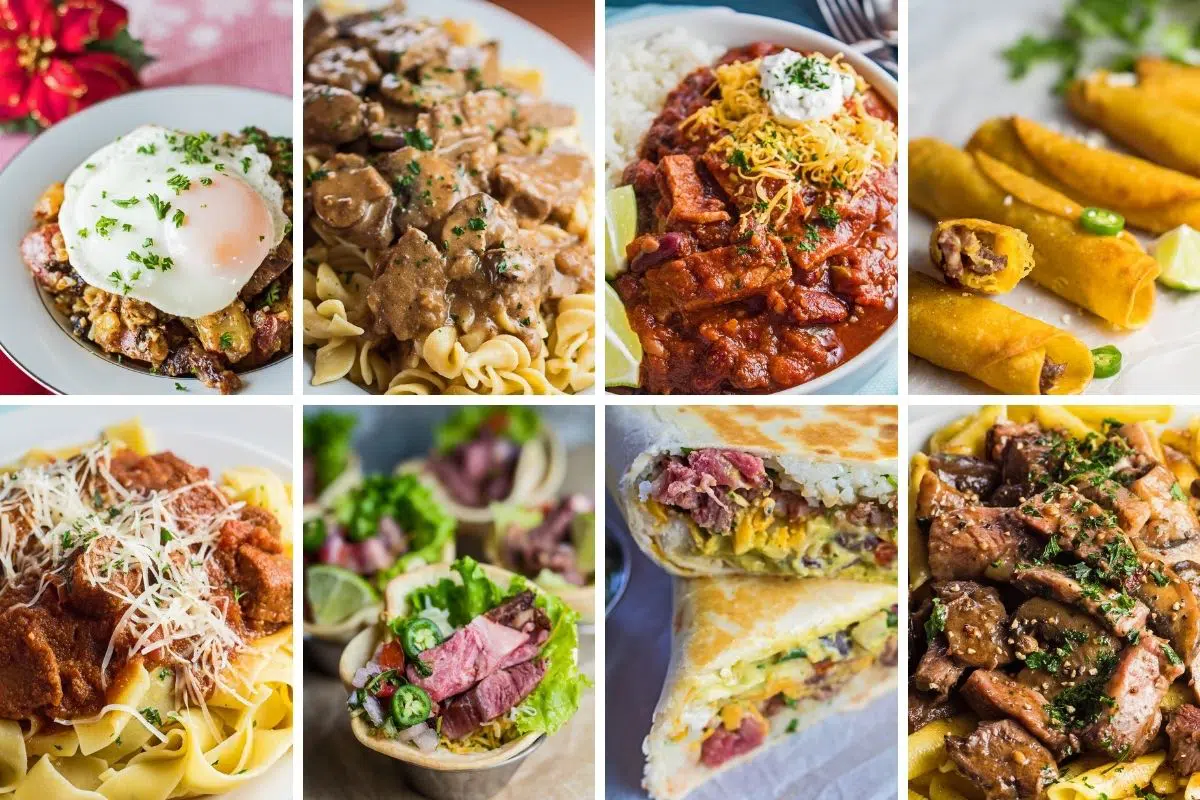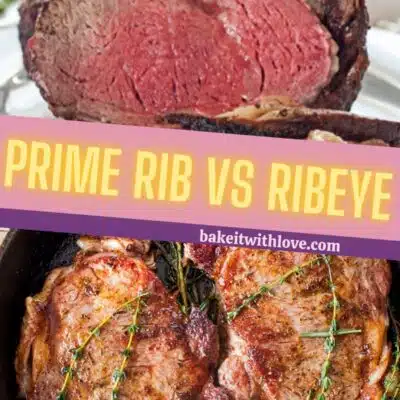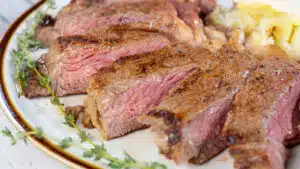Prime rib vs ribeye steaks: everything you need to know, including the differences between them as well as all the ways they're similar! From taste and texture to how to cook each best, I cover it all! If you're a fan of these two delicious cuts of beef, you're sure to learn a thing or two!
Guide To Prime Rib & Ribeye Steak
Two of the most popular beef cuts to enjoy for great reason! These delicious cuts, whether you're shopping for a boneless prime rib, standing rib roast, tomahawk steak, or juicy, thick-cut ribeyes, never disappoint!
Prime rib is featured as the centerpiece of holiday meals, and ribeye steaks are served at well-known steakhouses nationwide. They're that good! But which is better?

Jump to:
- Guide To Prime Rib & Ribeye Steak
- Prime Rib vs. Ribeye: The Juicy Facts You Need to Know
- Difference Between Prime Rib and Ribeye
- Taste and Texture
- Difference In Cost
- How Are Prime Rib and Rib Eye Graded
- How To Cooke Prime Rib
- Prime Rib Recipes
- Why Do We Eat Prime Rib For Christmas
- How To Cook Ribeye Steaks
- Ribeye Steak Recipes
- Nutritional Differences
- Is Prime Rib Or Ribeye Better
- 📖 Recipe Card
- 💬 Comments & Reviews
Prime Rib vs. Ribeye: The Juicy Facts You Need to Know
Interestingly, prime rib roasts and ribeye steaks are not as different as many think. They are both made from the exact same primal cut of beef. This is the section of the cow that is designated as the primal rib section located on the back ribs.
The only major distinction between these two beef cuts is that they are cut and cooked much differently.
Difference Between Prime Rib and Ribeye
Prime rib is the more traditional cut of roast beef. You can either have this cut of meat boneless or bone-in. Most people choose to cook the bone-in cut so they can have that added kick of beefy flavor (plus a built-in roasting rack!).
The prime rib is actually cut from the ribeye muscle, which is on the higher back portion of the cow. This cut is a combination of the sixth through twelfth ribs (with most roasts having between 2-7 ribs).
Located between the chuck and short loin sections, this is one of the most tender portions on this animal because this particular muscle doesn't receive much movement or exercise.
There are 3 different muscles that make up the rib eye steak: spinalis, longissimus dorsi, and complexus. Let's dive a little deeper into what these muscles mean for the texture and flavor of this steak.
Spinalis
This is the portion of the rib that is called the ribeye cap, cap steak, and also known as the 'rib crown.' This muscle is connected to the ribeye and is only separated by a single layer of fat.
Longissimus Dorsi
This muscle is the legitimate "eye" portion of the ribeye which is located in the center of the rib steak. This well-marbled center cut is a circular shape that is surrounded by other fat and the two muscles it combines with to make up the entire ribeye steak or prime rib.
Complexus
This is the smallest muscle out of the three that is actually attached to the 'eye,' which is the longissimus dorsi.
>>>>See all of my recipes here<<<<
Taste and Texture
Prime Rib
Prime rib is one of the richest, most tender beef cuts you will probably ever taste. The more intensely wonderful flavor you experience when eating this cut of meat is easy to distinguish because of the wonderful amount of marbling, bone, and connective tissue associated with it.
Whenever you think of steak or roast, you imagine a nice beefy flavor, and that's exactly what you get from a perfect prime rib roast.
To get the most out of your roast, you should cook your prime rib to medium-rare. If you cook your prime rib over medium, the meat will lose the tenderness that makes it so unique.
Ribeye Steak
Ribeye is also extremely tender since it is cut from the same portion of beef. However, the prime rib is usually considered to be more flavorful. This is because of the larger roast being cooked with all of the marbling and bone, adding to the rich, beefy flavor that makes a prime rib so darn good!
Both rib-eye steaks and prime rib feature the perfect amount of fat marbled throughout the meat to produce a buttery and rich taste. The awesome part? While the meat is cooking, the marbled fat will continue to render down, which bastes the meat from the inside out.
Difference In Cost
Where you buy your rib eye or prime rib will directly affect the price you pay. Quality is important, but note that you can sometimes find the best quality in your backyard.
Talk to your local butcher, and you will likely find not only an exceptional cut of beef but also a very acceptable price tag!
As of today, I'm seeing a two-pack of ribeye steaks (approximately 1 to 1 ½-inch in thickness) priced at about $25 combined, or $12.48/pound, and a tomahawk at $35 when shopping at Walmart. My local grocer (where I buy the whole prime rib roast or rib roll) is priced at $9.49/pound.
You can certainly pay upwards of $400 for a whole bone-in prime rib roast (I just looked! - Google 'prime rib roast' and look at the offers on the top of the page). In short, there's quite a range in costs you would pay per ribeye steak and per pound for your roasts, too.
I find it very economical to buy a whole prime rib cut and then cut off two roasts and between 6-8 ribeye steaks. Freeze 'em, and you're good to go for a month or two.
How Are Prime Rib and Rib Eye Graded
The title prime rib tends to lead some people astray when they're trying to understand how the cut of meat is graded. The "prime rib" title doesn't classify the grade of the meat. It only refers to the cut of meat you're getting.
When you get a "prime rib," this can be graded by the USDA as one of two grades. The grades are prime or choice (select is another USDA grade level, but you won't see prime rib offered from a select-graded beef carcass).
So, you can have a 'prime' grade prime rib or a 'choice' grade prime rib. The same holds true for your ribeye steaks. They are available as prime or choice, and select is not usually offered or noted.
At the supermarket or butcher's counter, these cuts should be clearly labeled, so make sure to read the packaging (or labels). For some added visuals to see the difference between grades, check out this post.
How To Cooke Prime Rib
Given the prime rib (either boneless prime rib or standing rib roast) is a roast, you want to slow-cook this meat every time. On the other hand, the ribeye steak can be pan-seared at high heat to a delicious medium rare.
Whatever you call it - cube roll, rib roll, prime rib, ribeye roast, rib-eye roll, standing rib roast, or OP rib (oven-prepared rib) - this tasty, traditional holiday roast is a spectacular treat at any time of the year!
Check out my post on prime rib cooking temperatures to ensure you cook your prime rib to perfection! I've also included a few of my favorite recipes to try below!
Prime Rib Recipes
- Smoked Prime Rib - Rich and smoky prime rib roasts are worth every moment of the wait! Bone-in or boneless prime rib shines with this super easy yet intensely flavorful cooking method! (You could also try my smoked bison prime rib)!
- Oven Roasted Prime Rib - This flavorful boneless prime rib roast is seasoned to perfection with my favorite dry rub for prime rib! Serve it up for a special dinner, or treat your Christmas holiday guests to a meal fit for a king!
- Horseradish Roasted Garlic Crusted Prime Rib - That luscious crusting on a well-roasted prime rib is taken to new levels of deliciousness with this easy horseradish and roasted garlic seasoning! It's the perfect flavor combination with prime rib. In fact, I like to serve it with some horseradish sauce on the side for even more flavor!
- Grilled Prime Rib - My favorite way to prepare prime rib in the summertime! The meat is so tender and juicy, with that wonderful flame-kissed flavor from the grill that is simply hard to beat.
- Christmas Prime Rib Roast - This show-stopping roast makes the perfect centerpiece for your Christmas dinner table! It has a thin layer of horseradish that gives the meat so much wonderful flavor!
- Standing Rib Roast - A picture-perfect bone-in prime rib roast that will have everyone scrambling to the table! The meat is fall-off-the-bone tender from being roasted low and slow.
- Boneless Prime Rib - Another classic roast with easy instructions, perfect for the holidays.
Once you have your prime rib recipe picked out, take a look at all of the best side dishes to serve with prime rib! Be sure to also check out all of my incredibly tasty leftover prime rib recipes so you can use your roast to make the very best prime rib recipes to treat yourself to!
Why Do We Eat Prime Rib For Christmas
The origin of the prime rib goes back to Britain during the time of the Industrial Revolution. This time period is when the standards regarding butchering meat improved drastically so that people could enjoy more cuts of beef (such as prime rib).
Prior to the 1940s, prime rib was considered to be a great economical choice for the holidays. Turkeys were something that only wealthy individuals could afford, as they were only available during mass turkey shootings. Plus, home freezers and mass-produced poultry weren't widely available.
As time progressed, prime rib remained one of the top choices for Christmas dinner.

How To Cook Ribeye Steaks
This cut has developed a couple of names to describe the type of steak you choose. The Tomahawk references the bone-in ribeye that you see with the protruding rib bone, the Cowboy cut is still attached to the bone, while beauty steak, Delmonico, sarket steak, Scotch fillets, and Spencer all reference the boneless ribeye steak.
Ribeye Steak Recipes
- Pan-Seared Ribeye Steaks - All of my tips for absolutely nailing the pan-seared ribeye are shared here! That way, when the weather prohibits grilling, you can still enjoy a steakhouse-quality dinner!
- Sous Vide Ribeye Steak - Sous vide is the way to go for the most tender and succulent steak! You don't even need a sous vide machine, just a large pot, and a gallon-sized Ziploc bag!
- Reverse Sear Tomahawk Ribeye - The reverse sear is another great way to cook up any thick-cut steak portion! Perfectly medium-rare is the way to go with this hearty tomahawk ribeye steak!
- Baked Ribeye Steak - An easy recipe for perfectly cooked oven-baked ribeye steaks. All you need is steaks, oil, and a little steak seasoning!
- Grilled Ribeye Steak - This is a summer grilling recipe you'll want to make again and again! The perfect sear marks are what steak lovers' dreams are made of!
- Smoked Ribeye Steak - The steak absorbs all of the wonderful smokey flavor as it's cooked low and slow in your smoker! You can reverse-sear the steak at the end to get a perfect crust!
- Broiled Ribeye Steak - Once you see how easy it is to get a perfect steak by just popping it under the broiler for a few minutes, you'll wonder why you haven't always cooked them this way!
If you are counting macros, I have an entire guide to the nutrition and calorie content of ribeye steaks! I also have a whole post dedicated to what to serve with ribeye steaks to help complete your meal!
Nutritional Differences
Both the prime rib and ribeye have similar nutritional values, with some key differences. Prime rib has a higher fat content, which increases the caloric content.
For example, 100 grams of prime rib is 355 calories while 100 grams of ribeye is 291 calories. With larger portions, the difference between these amounts becomes greater.
Aside from the fat and calories, prime rib and ribeye have incredibly similar nutritional values.
Is Prime Rib Or Ribeye Better
These are both great options, and you won't go wrong with either! The final decision will really just depend on which cooking method you're up to tonight and your personal preferences!
If you're in the mood for a traditional slab of steak, then you should go for the ribeye, but if you want a nice piece of roast, the prime rib is definitely my go-to. Try them both out so you can finally decide for yourself which one is the better option for you!
These two cuts of meat are both incredibly delicious, so you really can't go wrong! Let me know your favorite ways to prepare prime rib and/or ribeye steaks in the comment section below!
Do you love a recipe you tried? Please leave a 5-star 🌟rating in the recipe card below and/or a review in the comments section further down the page.
Stay in touch with me through social media @ Pinterest, Facebook, Instagram, or Twitter! Subscribe to the newsletter today (no spam, I promise)! Don't forget to tag me when you try one of my recipes!
📖 Recipe Card
Prime Rib vs Ribeye: Baked Ribeye Steak (+Everything You Need To Know!)
Ingredients
- ½ tablespoon beef tallow (or extra virgin olive oil)
- 8 oz ribeye steak
- ½ tablespoon steak seasoning (to taste)
(Note: 2x or 3x only changes the ingredient list)
Instructions
- Preheat your oven to 400°F (205°C). Add beef tallow to a cast iron skillet or heavy-bottomed oven-safe skillet and place it over high heat.
- If your steak is not already seasoned (*see note), pat it dry with some paper towels and then season all of the sides using steak seasoning.
- Once the beef tallow is nice and hot, add the seasoned ribeye to the pan and sear the meat for 2-3 minutes per side (use tongs to hold the steak in order to sear the sides).
- Once seared, move the skillet to the preheated oven and bake at 400°F (205°C) for 10-15 minutes, or until the meat reaches your desired doneness when checked with a meat thermometer.
- Remove the cooked ribeye and transfer it to a plate or cutting board. Then, loosely tent some aluminum foil over top and allow it to rest for 5 minutes before serving.
Notes
- Remove your ribeye from the fridge and place it on the counter an hour before cooking.
- To dry brine your steak (for best flavor), season your ribeye and leave it uncovered in the fridge overnight.
- I love using beef tallow for searing steaks as it has a rich, beefy flavor and a high smoke point of 420°F (215°C).
- Using a meat thermometer is the best way to know when your ribeye is done cooking. Pull your steak from the oven 5°F before your desired temperature, as it will continue to cook while resting (called "carryover cooking").
- Rare: 115-120°F (46-49°C)
- Medium-Rare: 120-125°F (49-52°C)
- Medium: 130-135°F (54-57°C)
- Medium-Well: 140-145°F (60-63°C)
- Well: 150-155°F (66-68°C)
- To store: Keep any leftovers in an airtight container in the refrigerator for up to 3 days.
- To reheat: Reheat your ribeye by baking it in the oven at 250°F (120°C) until it is warmed through. For more tips and ideas, take a look at my guide to reheating steak.



Comments
No Comments